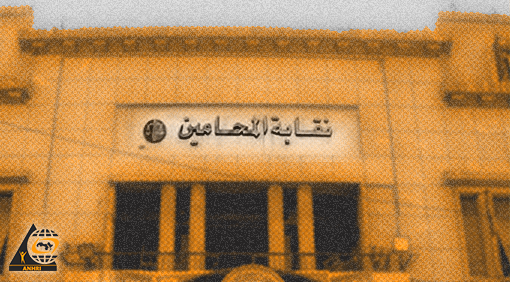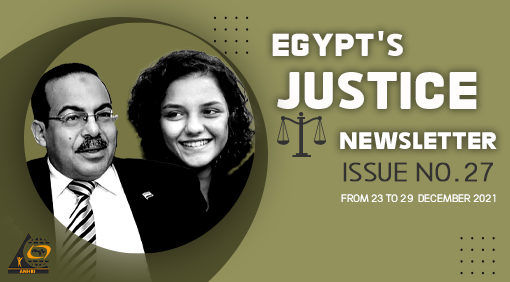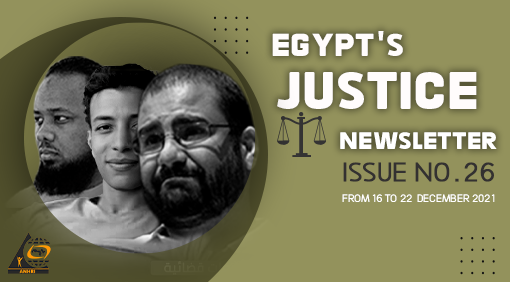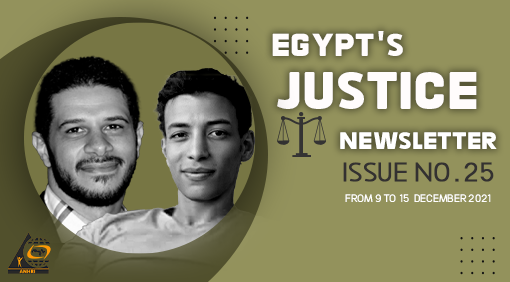
By: Ahmed Qenawi, Lawyer before the Court of Cassation
Introduction:
The 109-year-old Egyptian bar association was established in 1912. In this long journey of the bar association, for the major part of its history, the developments and setbacks in the state of public rights and freedoms is fully reflected. As an active part in the structure of the Egyptian civil society institutions, the bar association contributed and fought battles, was victorious, retreated, the authority was always present, either gently or by making a satisfying arrangement for it or by direct intervention. The goal was always to tame the bar association and make it one of the obedient institutions, even if this contradicted its original role in defending the rights and interests of its members.
The pre-1952 revolution stage
Since its inception, the bar association has been involved in one of its most important roles, in issues related to the country and to freedoms. During the 1919 revolution, the bar association was present, and it embraced the symbols of the 1919 revolution and announced its first strike in 1919 in protest against the exile of national leaders, and it was the first strike carried out by a union in Egypt.
It is no coincidence that its first head was the one who participated in drafting the first constitution Egypt has ever known. The bar association was an important source for the national movement in Egypt. Several ministers and prime ministers in the pre-1952 period came from it. Makram Ebeid and Morcos Pasha Hanna held the position of its head as an example of its sincerity in adopting Egyptian citizenship, not just rhetorically, but practically as well.
Between 1946 and 1949, the bar association had two remarkable occurrences, the first is related to the rights and freedoms issue, and the second related to the cause of independence. The first was related to the declaration of an arrest warrant for a number of national figures and the confiscation of a number of newspapers, with the accusation of plotting an armed coup pressed against these figures. The bar association represented the defendants through the head of the bar at the time, “Omar Omar”. The Public Prosecution had relied on mere investigations conducted by the political police, and through the cross-examination of two witnesses from the police, it became evident that there was no meeting and that the arrests were made on the public road and the charge was dropped. The second was the battle that the bar association fought to abolish the mixed courts considering that their existence lessens from sovereignty, equality and independence. The bar association won, and the mixed courts were abolished in 1949, and consequently, the bar association before mixed courts was also abolished.
March 1954 and a turning point towards subordination
This period is referred to as the March 1954 crisis, in which there was a struggle between Mohammed Naguib and the Revolutionary Command Council over the return of parliamentary life and the return of the army to its barracks, or entering into a system of government that some see as military, revolutionary or dictatorial. The bar association did not stand aside in this conflict, which seemed to be one between the rule of law and the military state, the bar association at the time sided with the state of law. This siding did not take the form of a mere statement or by taking a stance at the Bar’s Council, but through a general assembly meeting held on March 26, 1954. At this meeting, a decision was made calling for the restoration of Egyptian parliamentary life, and the response came quick, to dissolve the Council of the bar association by the Revolutionary Command Council.
Then came the second move in order to subordinate the bar association in 1968, as it was decided to include public sector lawyers in the bar association, and then they had the possibility to vote and became members of the General Assembly of the bar association. This came in an attempt to support Chief Ahmed Al-Khawaga who was running against an independent opponent, and indeed he succeeded, Ahmed Al-Khawaga became head of the bar association, and this marked a significant shift in the agenda of the General Assembly. Then an amendment was made to Law No. 56 of 1970, amending Lawyers Law No. 61 of 68, to include members of the public sector for membership of the the Bar’s Council.
Battles fought by the bar association against Sadat and Camp David
The bar association fought one of its most important battles against the Camp David Accords that Sadat made with Israel. The spearhead in that battle was the head of the bar association at that time, “Abdel Aziz Al-Shorbagy”. Conferences were held, statements were issued, demands and slogans were formulated, including raising the slogan of a million Palestinian flags against the flag of Israel. Sadat had no choice but to refer Al-Shorbagy to the Socialist Public Prosecutor on charges of calling for the overthrow of the regime. Sadat’s speech in Mansoura included an allusion to Abdel Aziz Al-Shorbagy with negative criticism, in an attempt to get rid of him, and preparing to bring back Ahmed Al-Khawaga as chief once again.
The era of President Sadat ended and was preceded by the famous arrests of September 1981, and among those arrested were members of the Bar Association Council, as it was the Freedoms Committee in that period that led, along with the head of the Bar at that time, an ongoing and escalating activity against Sadat and the Camp David Accord.
Manifestations of the bar association crisis of January 1989
In 1985, during the formation of the syndicate Council, Chief Ahmed Al-Khawaga decided that the bar needed a supportive freedoms committee and not a pressuring one, and therefore he called and campaigned to remove the Wafdist leader Ahmed Nasser from leading it in a clear attempt to subordinate the freedoms committee, as it is the most important committee of the bar, and one which embodies it when it comes to nationalistic and patriotic issues, to such extent that the Secretary General of the bar association at the time took up the defense of leaders in the Ministry of Interior accused of torturing citizens, which is the famous case referred by the former Public Prosecutor Mohammed al-Gendy, and the gap was widening little by little in two directions, one trying to preserve the heritage of the bar association, and the other accepting, after hesitation, that it would be controlled and stripped of its ethical role in issues in favor of rights and freedoms, which became an important aspect of the bar association’s structure, whether for the regime or the popular circles.
On the professional level, at that time the bar association’s register was overcrowded as a result of wrong educational policies. The attacks on lawyers escalated, and the performance of the syndicate remained modest, working in the same way as when its register had a few thousands, not hundreds of thousands. On the national level, the bar association had a setback, along with the freedoms committee. A no confidence motion against the head of the bar association and members of the Council was passed, according to a provision in the Legal Practice Law at the time that allowed for this. This was the first no confidence vote in the history of Egyptian professional unions. There was no official vision yet, because the no confidence vote came as a surprise, but just a few days later, that vision decided that it was necessary to strike the idea of that association. At the official level, many lawyers were imprisoned, others were disbarred, and unlimited government support was provided to Chief Ahmed Al-Khawaga. This continued until 1992, during this year the Court of Cassation issued a ruling invalidating the council of Chief Ahmed Al-Khawaga, and so there was no longer any legitimacy except for the temporary committee headed by Dr. Mohammed Asfour, but the authority was strongly bent on preventing this, so the parliament convened on the night of the ruling and amended the law of legal practice, hours after the ruling of the Court of Cassation, and made the head of the Cairo Court of Appeal the mandate holder in the bar association, according to Law No. 98 of 1992 by adding a second paragraph to Article 135 bis of the Law, which was reads as follows (a third paragraph is to be added to Article 135 bis of Law No. 17 of 1983, which states the following: “A temporary council is to be formed, and it is to be led by the head of the Cairo Court of Appeal, and with the membership of the six most senior presidents or vice-presidents of this court. It alone shall have the exclusive jurisdiction to conduct the elections within a period not exceeding sixty days from the date of the invalidation ruling. If any of them apologized or something hindered them, they are to be replaced by the next most senior member. This council, until a new council is formed, shall have all the competencies of the council, and its president shall have the competencies of the head of the bar. The Court of Cassation, exclusively, is competent to rule on appeals against its decisions on the dates and procedures stipulated in the previous two paragraphs.”) Syndicate elections were held and Ahmed Al-Khawaga barely succeeded because of the Muslim Brotherhood’s alliance with him and none of his council members succeeded, but this highlighted the possibility of reconciliation with transparent elections even if the results were partly unsatisfactory.
Receivership of the bar association…. Al-Khawaga from chief to reciever
To save himself, the late Chief “Ahmed Al-Khawaga” was forced to ally with the Muslim Brotherhood and abandon his list, and the result was the success of Al-Khawaga and the Muslim Brotherhood’s list, and it won the majority of the seats in the council. This victory called for the issuance of Law 100 of 1993 regarding guarantees of democracy for professional trade union organizations. It placed restrictions on the validity of holding general assemblies to ensure the participation of the largest number of members of a general assembly in elections, as this is an effective way to prevent the victory of the Muslim Brotherhood. The authority, along with Al-Khawaga, instead of respecting the judicial rulings regarding the legitimacy of the temporary committee led by Professor Dr. Mohamed Asfour, which is a committee closer to Egyptian liberalism, they indirectly prevented it from doing its job, the result was the success of the Muslim Brotherhood in winning the majority of the council seats.
In less than a year and half, the council, which was mostly composed of Muslim Brotherhood members, was, in a legal precedent, placed under receivership based on a ruling issued for partially union-related reasons and mainly for political ones, which is the alliance of trade unions which made political demands, and so came the ruling of the receivership and made the head of the bar association and two others, one of whom refused, receivers over the bar association.
The Muslim Brotherhood refrained from resisting the imposition of receivership, which was welcomed by a large sector of those who were against the Muslim Brotherhood. A few opposed it, who rejected both, and formed a third way, rejecting the policy of the Brotherhood and what was called at the time the nationalist forces in the union, as they were complicit in imposing receivership on the most important professional unions in Egypt; the bar association. The receivership lasted for eight years, during which forces emerged that fought against the receivership, including the Salvation Front, the Lawyers’ Unity Committee and other forms until the Cairo Court of Appeals issued a ruling lifting the receivership in 1999, for the bar association to enter again into electoral battles according to Law 100 of 1993, and back then, the late head Ahmed Al-Khawaga had died before the receivership was lifted.
Sameh Ashour … Al-Khawaga’s path to subordination
Sameh Ashour presented himself in 2001 as an opponent of both the government and the Muslim Brotherhood. The government pushed Ragaei Attiya as its candidate and the Muslim Brotherhood announced their support for him. The elections resulted in Ashour’s victory as head of the bar association with many members of the council that belong to the Muslim Brotherhood. The elections established what was known at that time as the national list against the Muslim Brotherhood’s list. Neither of the lists belong in a union, the membership of either one of them does not require a unionist as much as it requires a fully loyal person.
Then came the 2004 elections with almost the same result in favor of Chief Sameh Ashour, and the bar’s decline in contributing to the national field continued, as it was in the period of Chief Al-Khawaga. The performance of a chief who won as a member of the opposition was closer to the government chiefs. The 2008 elections came and Chief Hamdi Khalifa won as a result of the anger at Sameh Ashour and his practices. If he was a pro-government, then what was the difference between him and Hamdi Khalifa, this was the perception at the time.
Hamdi Khalifa, a head with whom both the January revolution and the Constitutional Court caught up
Hamdi Khalifa, a member of the National Democratic Party (el Watani Party) in a syndicate, that historically used to elect an opposition head, even by appearances, but the performance of the one who claimed to be an opponent and from the trenches of the heritage of the bar association and then showed his crude pro-government practices; Sameh Ashour, narrowed the gap between pretending to belong to the opposition and the clear and explicit pro-government, so the lawyers chose the clear and explicit. However, the bar association, in its formation, was unable to digest the idea of a crude pro-government head. All of this had manifestations, including hanging banners that could be interpreted as pro- government partisan propaganda on the walls of the bar, so the lawyers forcibly removed them. The appeal to Law 100 of 1993 regarding the democracy of professional unions had gone a long way to The Constitutional Court, in the meantime, the January 25 Revolution erupted and Hamdi Khalifa was considered one of the remnants of the previous regime, especially since the bar association was involved through ordinary lawyers in the revolution, including the huge march to Abdeen Palace on 10/02/2011 and time did not help Hamdi Khalifa, as a verdict was issued by the Supreme Constitutional Court rendering Law 100 of 1993 unconstitutional, according to which he was elected, and therefore his presence as a head of the bar became null after the administrative court’s ruling was issued. And with this, the period of Cheif Hamdi Khalifa came to an end.
The bar association and the January Revolution
The bar association was the only union in Egypt that opened its doors on January 24, 2011 in preparation for participating in the morning of the following day, January 25, 2011, which was thanks to a number of lawyers and not its council, which was preoccupied fighting the last lost battle to remain in the bar association, on the morning of January 25, 2011, the lawyers had raised banners from behind the doors that were forcibly closed by the security, and by noon and with the many demonstrations that passed from Ramses Street, the bar association reopened its doors so that the lawyers could join the rest of the protesters of the January revolution.
In the midst of the revolution, specifically on February 10, 2011, the most important demonstrations in the history of the bar association erupted, which went to Abdeen Palace, calling for Mubarak to step down.
From January 2011 to 2013, the bar association witnessed a diverse and important movement for all powers, between the advocates of the constitution first or those who approved the constitutional amendments, and the bar association turned into a wide platform in which all forces freely expressed their ideas and visions, in a reaffirmation of what was cut, continuing on the path that was stalled, and transcending the stumbling blocks of regimes that shackled it with security intervention at times and legal or even judicial intervention at other times.
Sameh Ashour again, the subordination policy continues
For 19 years, Sameh Ashour held the position of Head of the Bar Association, during which amendments were made to the legal profession. The first was specific to the sub-syndicates and the method for electing the members of their councils. The essence of the amendment was that the selection be made at the fractional level, another amendment was made after that by making it over an entire area of the sub-syndicate. Then another amendment granted the Council of the Bar, and not the General Assembly, the power to issue a decision to establish a sub-syndicate when the Minister of Justice decides to establish a Court of First Instance. The aim of the last amendment was to break up the sub-syndicates, particularly in Cairo. Instead of one syndicate, it became 4 syndicates, with the functions of the sub-syndicates remaining the same. This amendment was, like many others, for electoral reasons, aiming to ease the control of the head over the general assembly. The individual nature of head Sameh Ashour contributed to the bar’s work to transform the council into a mere number that he decided in the amendment to be 54 members and then lowered it in another amendment to 28 members without any powers but only signatures, most of which are in favor.
The Central Agency for Oversight, mentioned in its reports the existence of many violations. The bar’s ideas came to limit admission to the bar association’s register – something that it did not seek in any amendment – except by placing illegal restrictions on renewing registration and paying the syndicate membership fees in violation of the law. There was a clear grumble among the ranks of lawyers, then came the last amendment to Law 147 of 2019 which was a major disaster, as it allows the head of the bar to remain for various terms after it was limited to two terms in a row, and then other amendments to the articles regulating the no confidence motion, by adding conditions that make it almost impossible. Then came the 2020 elections, just as the lawyers chose Chief Hamdi Khalifa before, they chose Ragaei Attiya as chief of the bar, for reasons closer to revenge and anger than to a real choice based on a union vision.
Ragaei Attiya… A competition in subordination
- Ragaei Attiya ran in the bar association elections for the chief’s seat three times before, before he succeeded as chief the fourth time. Those who rejected him three times were the same ones who voted for him. It is certain and known that voting for him was a punishment for the former chief, Sameh Ashour, for the overall weak and individualistic performance of the bar. He used to rely on interest groups related to wrongdoing that is no longer hidden.
- The comparison made by lawyers, or most of them, was not a comparison between a chief affiliated with the government and another who had an independent vision, even if it contradicted it. Rather, the most important goal for large sectors of lawyers was the inevitability of dropping Sameh Ashour, and it happened with a difference of so many votes.
Ragaei Attiya is not much different from Sameh Ashour except in two matters: (first) fighting against rampant corruption in the bar association (second) not relying on a group that defends his decisions among lawyers, even if it violates the law and contradicts logic.
- In the public domain, the current head competes with the former in further subordination of the bar association. He rejected the attempts of many lawyers to merely express positions related to freedoms or national issues. This was clear as he was among the promoters of Saudi Arabia’s ownership of the islands of Tiran and Sanafir shortly before he ran for the elections and this was his ticket to pass… But the problems of lawyers and real professional issues always remain absent in those times.
The absence of a professional agenda
- The division in the bar association dates back to 1992, when there were two non-union factions that controlled the reins of affairs in the bar association, the Muslim Brotherhood, and the Sameh Ashour Group.
This division could have been overcome by offering professional and union programs as they are the goal of any union organization, and these programs or professional agendas could have bridged the gap that was once manifested in the bar association that Sameh Ashour presented an amendment to the Law of Legal Practice and on the day of its discussion in the parliament, there was a protest supported by the Brotherhood against the project, not because this law does not meet the interests and ambitions of lawyers and its connection to the real issues of lawyers, but also because the opinion of the council, most of which belonged to the Muslim Brotherhood, was not taken into account.
- Lawyers are paying a heavy price as a result of the absence of a professional union agenda, as:
– Replacing lawyers’ cases with manifestations of division, and replacing the lawyers’ unity on real union cases with daily jousting and mobilizing to support people without visions.
– Attacks on lawyers are on the rise, and so are the obstacles to their professional work.
- Low union services and lack of real control over lawyers’ funds
– The disintegration of the sub-syndicates and making them mere small cantons with no vision or position
– Deliberate negligence when it comes to defending lawyers imprisoned in opinion cases or related to their right to freedom of expression or peaceful political action.
Conclusion:
If this modest research paper may contribute to what is believed to be a professional and union agenda, then it points to:
1 – The need to limit the bar association’s register to freelance lawyers, and that lawyers in the public sector or in the business sector and public agencies and institutions should join the State Sector Authority or establish an independent union.
2 – That the bar association becomes in charge of its agenda by defining each year the number of accepted lawyers and the conditions for that in accordance with general, abstract rules.
3- Amalgamation of the sub-syndicates that have been fragmented, transferring services to them, and limiting the role of the general union to defending the profession’s policies.
4- Digitizing the bar’s work and linking the sub-syndicates with the general union and improving the quality and speed of services with simple and convenient electronic applications.
5- Making the defense of the independence of the judiciary one of the main priorities on the national level in the bar association.
6- Preparing a complete and independent register for lawyers working abroad that takes into account their interests and contributions to the bar association’s resources, and consequently the pension they deserve.
7- Restoring the national role of the bar association, which is related to the constitutional rights enshrined in the constitution, such as the rights to freedom of expression, the right to defense and other rights.
for pdf
for word







